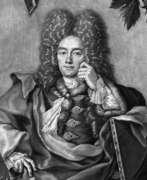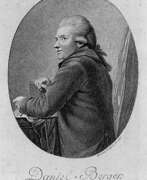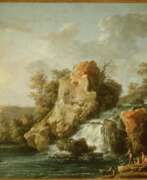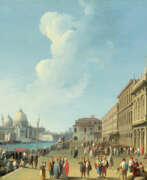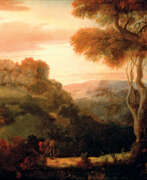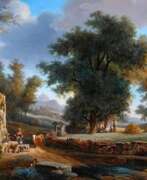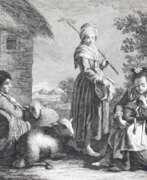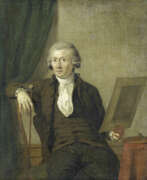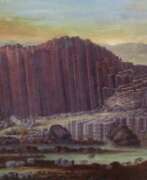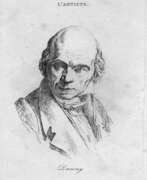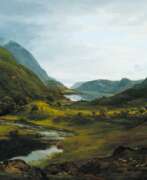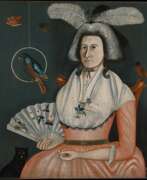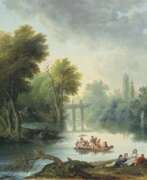Landscape painters 18th century


Fyodor Yakovlevich Alekseyev (Russian: Фёдор Яковлевич Алексеев) was a Russian painter born around 1753 in Saint Petersburg. Known as the "Russian Canaletto" for his masterful vedute, or detailed paintings of cityscapes, Alekseyev made significant contributions to Russian art, particularly in depicting urban landscapes.
Alekseyev was admitted to the Imperial Academy of Arts in 1764, where he initially studied ornamental sculpture and scenic painting under Antonio Peresinotti. He spent several years in Venice, funded by a fellowship, where he studied theater painting but preferred creating landscapes and copying works by old masters. Upon his return to Russia, he faced restrictions but gradually gained recognition for his independent work. His notable painting "View of the Palace Embankment from the Fortress" earned him the title of Academician in 1794.
In 1800, Tsar Paul I commissioned Alekseyev to paint the streets and architecture of Moscow, resulting in numerous significant works that highlighted the city's grandeur. Despite a decline in fame later in life, his contributions to Russian urbanscape painting remain influential, with works such as "Red Square" and "The Flood of 1824 in the square at the Bolshoi Kamenny Theatre" held in major Russian museums like the State Russian Museum and the Tretyakov Gallery.
For updates on sales and auction events related to Fyodor Yakovlevich Alekseyev, sign up for our newsletter.


Johann Adam Ackermann was a German landscape painter of the early 19th century. His best-known works are his winter landscapes and watercolours. Johann Ackermann was the brother of Georg Friedrich Ackermann, who also painted landscapes but with less success.


Elias Baeck called "Heldenmuth", was a German painter and engraver from Augsburg. Baeck worked for some time in Rome, then in Laybach, but finally returned to Augsburg, where he died in 1747. His chief works — both in painting and engraving — were portraits and landscapes. His engravings are sometimes signed "E.B.a.H.", standing for "Elias Baeck, alias Heldenmuth".


Ludolf Bakhuizen was a Dutch painter of the 17th and early 18th centuries. He is known as an outstanding master of seascapes. Bakhuizen also painted biblical themes and portraits of his contemporaries as well as engravings and miniature models of ships.
Ludolf Bakhuizen is considered one of the best marine painters of the Golden Age of Dutch painting. Among the admirers of his work were many influential European rulers, including the Russian Tsar Peter the Great. The master met Peter I, who visited Amsterdam in the mid-1690s and, according to contemporaries, even managed to give some painting lessons to the Russian tsar. In addition, Вakhuizen made models of all kinds of ship designs on commission from Peter the Great.
Toward the end of his life, the Amsterdam authorities honored Bakhuizen by opening his own gallery on the top floor of the City Hall for his achievements in the fine arts. The best masterpieces of his work are now preserved in museums in the Netherlands, Germany, England, France, and Italy.


George Barret the Elder was an Irish landscape painter.
He arrived in London in 1762, and soon became known in society and became a leading painter of the period. Barret exhibited at the Society of Artists of Great Britain and gained the patronage of many art collectors. In 1768, he co-founded the Royal Academy. During his lifetime Barret painted many fine landscapes of Wales, the Lake District, the Thames, views of castles and palaces, which were much sought after by the nobility.
His son, George Barret the Younger (1767-1842), also became a landscape painter, and he may even have surpassed his father in skill.


George Barret the Younger was a British painter, master watercolorist and landscape painter.
He was the son of the Irish painter George Barret the Elder (1730-1784) and learned painting from his father. He exhibited at the Royal Academy from 1800 and was one of the first and active members of the Society of Watercolor Painters, which was formed with his own encouragement in 1804. His early works were mainly topographical landscapes in a style similar to his father's watercolors. Later he switched to more romantic compositions with imaginary landscapes.
In 1840, George Barret published The Theory and Practice of Watercolor Painting.


Jean-Victor Bertin was a French landscape painter of the Classical period.
He graduated from the Royal Academy of Painting and Sculpture. His works were constantly exhibited in the halls of the Paris Salon.
Bertin was one of the pioneers of the practice of painting outdoors - plein air.




Thomas Birch was an English-born American portrait and marine painter.
He exhibited regularly at the Pennsylvania Academy of the Fine Arts for forty years, beginning in 1811, and managed the museum, 1812-1817. His work is collected at PAFA, the Library Company of Philadelphia, the Philadelphia Museum of Art, the Smithsonian American Art Museum, the U.S. Naval Academy, and the Museum of Fine Arts, Boston, among others. In 1833, he was elected into the National Academy of Design as an Honorary member.


Giuseppe Bernardino Bison was an Italian painter celebrated for his mastery in frescoes, landscapes, vedute, capriccios, and religious works. Bison's journey through art took him across Italy, leaving a legacy that bridged the 18th and 19th centuries. His education under the tutelage of Gerolamo Romani and Constantino Cedini at the Accademia of Venice laid the foundation for a career influenced by the luminaries of Venetian painting, such as Tiepolo and Francesco Guardi.
Bison's eclectic and versatile style made him a pivotal figure in prolonging the vedutist tradition. His oeuvre includes a significant number of graphic works alongside his frescoes and easel paintings, which often depicted topographical vedutas and fantasy scenes. He worked in various cities, including Ferrara, Trieste, and Padua, leaving behind numerous palaces and villas adorned with his frescoes.
His art found a market among the affluent non-aristocrats of the time, collaborating with art dealer Tosoni to produce landscapes and vedute that catered to local tastes. Despite his success in places like Trieste, Bison's later years in Milan were marked by smaller commissions and financial struggles.
Bison's works are preserved in esteemed collections worldwide, including the Cooper Hewitt, Princeton University Art Museum, University of Michigan Museum of Art, Clark Art Institute, Detroit Institute of Arts, and the Metropolitan Museum of Art, among others. His paintings, such as "The Arsenale in Venice," "The Hermits of Thebes," and "Capriccio of Padua," continue to captivate audiences with their intricate detail and historical value.
For collectors and experts in art and antiques, Bison's legacy offers a unique glimpse into the transition of Italian painting from the 18th to the 19th century. His ability to blend realism with fantastical elements makes his work a fascinating study in the evolution of European art.
For updates on exhibitions, sales, and auctions related to Giuseppe Bernardino Bison's works, sign up for our newsletter. Stay informed on the latest discoveries and opportunities to acquire pieces by this remarkable Italian artist.


Romolo Panfi was an Italian painter, of the late Baroque period, active mainly in Florence. He was active mainly as a battle painter and landscapes. He was a pupil of Jacopo Vignali and worked in the Medici court of Grand Duke Ferdinand and his brother, Cardinal Leopoldo de' Medici. He trained under Giovanni Camillo Sagrestani. He executed works in the church of San Frediano in Cestello, in the Oltrarno district of Florence. He also painted for the Palazzo Capponi-Covoni near the Nunziata in Florence.


Pieter Bout was a Flemish painter, draughtsman and etcher. He is known mainly for his landscapes, city, coast and country views and architectural scenes painted in a style reminiscent of earlier Flemish masters such as Jan Brueghel the Elder.


Johann Christian Brand was an Austrian landscape painter and graphic artist, copperplate etcher.
He received his first lessons in painting from his father, the landscape painter Christian Hilfgott Brand (1695-1750), then studied at the Vienna Academy of Painting. In 1758 Brand was commissioned by the imperial family for a series of hunting scenes. In addition to many landscapes, he also created 16 oil paintings for Vienna's Museum of Military History, depicting various types of cavalry of the Austrian army during the reign of Empress Maria Theresa.
From 1772 Brand was professor of painting at the Vienna Academy.
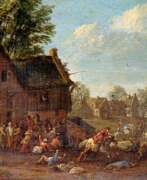



Luca Carlevarijs was an Italian painter and engraver working mainly in Venice. He pioneered the genre of the cityscapes (vedute) of Venice, a genre that was later widely followed by artists such as Canaletto and Francesco Guardi.


Michiel Carree of Karé was a Dutch painter and decorator of the Golden Age.
Carree was a famous landscape painter: King Frederick of Prussia invited him to Berlin and appointed him court painter. After the king's death, he returned to Holland and was mainly engaged in decorating the palaces of the noble townspeople. Carrée often depicted livestock in his landscapes, and these paintings can now be seen in the Rotterdam Museum.


Jacob Cats was a Dutch painter, printmaker and graphic artist.
He was famous for his urban landscapes and landscapes with realistic portrayals of people and animals. His works were distinguished for their originality, poetic rendering of the features of nature and depth.
His works are represented in almost all major public collections in the Netherlands.


Pierre-Athanase Chauvin was a French painter active in Italy.
Chauvin was a student of the landscape painter Pierre-Henri de Valenciennes. He began his career at the Paris Salon in 1793 and won the First Class Medal in 1819 with his painting Charles VIII’s entry into Acquapendente. The painting was commissioned by Louis XVIII of France for the Galerie de Diane at the Palace of Fontainebleau.


John Constable was an English landscape painter in the Romantic tradition. Born in Suffolk, he is known principally for revolutionising the genre of landscape painting with his pictures of Dedham Vale, the area surrounding his home — now known as "Constable Country" — which he invested with an intensity of affection. "I should paint my own places best", he wrote to his friend John Fisher in 1821, "painting is but another word for feeling".


Richard Corbould was an English artist. He was a painter, in oil and watercolour, of portraits, landscape, and occasionally history; of porcelain, and miniatures on ivory, and enamels; and was furthermore an important illustrator of books renowned for his Napoleonic sketches of Ships, and a follower of the old masters. From 1777 to 1811 he was a constant contributor to the Royal Academy.


Hendrik Frans de Cort was a Flemish landscape painter and draughtsman. In 1770 he became a master in the Antwerp Guild of Saint Luke. His early landscapes from the time before he moved to England were often made in collaboration with other Flemish artists. De Cort is known for his topographical views of English and Welsh landscapes. These were painted in an Italianate idiom indebted to the style of Gaspar Dughet. He often painted on specially prepared mahogany panels.


Jean Balthasar de la Traverse was a French painter and actor who worked in Russia during the 18th century. Born in 1752, he arrived in Saint Petersburg in 1773, joining a theatrical troupe and becoming a painter. He was patronized by Count Alexander Stroganov, for whom he created an album depicting views of Russian Empire cities.
De la Traverse is also known for his battle scenes from the Russo-Turkish War. His work, including landscapes and watercolors, was highly esteemed by contemporaries. The last records of him date to 1808.
Jean Balthasar de la Traverse's art continues to intrigue collectors and art historians. His mastery in depicting nature and historical events makes him a significant figure in art history. Subscribe for updates on new sales and auctions related to his works.


Simon Denis, a Belgian painter, is celebrated for his significant contributions to landscape painting. His journey in art took him from his native Antwerp, where he initially honed his skills under the tutelage of landscape and animal painter H.-J. Antonissen, to the bustling artistic scenes of Paris and ultimately to Italy, where he spent the majority of his career.
Denis's move to Rome in 1786, facilitated by the support of genre painter and art dealer Jean-Baptiste-Pierre Lebrun, marked the beginning of a prolific period in which his work attracted favorable attention. His marriage to a local woman in 1787 and his active participation in both the Flemish and French artistic communities in Rome underscore his integration into and influence on the local art scene. Notably, his technique was characterized by an exact and detailed approach, especially in his depictions of famous Italian landscapes, such as the waterfalls of Tivoli near Rome. This meticulous attention to naturalistic details and light effects distinguished his work during his time in Italy.
Denis's election to the prestigious Accademia di San Luca in 1803 attests to his recognition among his peers. In 1806, he settled in Naples, where he became the court painter to Joseph Bonaparte and later a professor at the Accademia di Belle Arti. His influence extended to teaching, with landscape painter Prosper Barrigue de Fontainieu among his pupils, demonstrating his role in shaping the next generation of artists.
Simon Denis's works, including "Study of Clouds with a Sunset near Rome" and "Landscape near Rome during a Storm," are held in prestigious collections such as the J. Paul Getty Museum and The Metropolitan Museum of Art, ensuring his lasting legacy in the annals of art history. For collectors and experts in art and antiques, Denis's oeuvre offers a window into the evolution of landscape painting, characterized by an immersive exploration of nature and meticulous attention to atmospheric effects.
To stay informed about new discoveries, sales, and auctions related to Simon Denis's works, signing up for our newsletter is recommended. This subscription is an invaluable resource for those looking to deepen their understanding of Denis's impact on landscape painting and to keep abreast of opportunities to acquire pieces by this masterful Belgian artist.


Johann Jakob Dorner the Younger was a Bavarian landscape painter. The son of Johann Jakob Dorner the Elder, he was born in Munich and was instructed in art by his father and by Mannlich. He travelled by himself through the picturesque regions of Bavaria, Switzerland, and France. His works are distinguished for spirited composition and taste in their execution. In 1803 he became Restorer, and in 1808 Inspector of the Royal Gallery at Munich, and was subsequently elected a member of the Academies of Hanau, Vienna, Berlin, and Munich.


Louis Fabricius Dubourg (Louis Fabritius du Bourg) was an historical and academic painter of arcadian landscapes, and an engraver.
He was a pupil of Gerard de Lairesse, Gerrit Rademaker (1672-1711) and Jacob van Huysum. In 1718 he became sexton of a small wooden church on Kerkstraat. Around 1726 he was practising foreshortening and may have been a member of an academy; he produced a lot of nude (art) during his life.


Johann Joachim Faber was a German landscape painter and printmaker. He initially worked on historical subjects. During his travels to Italy he became interested in landscape painting, in which he became known.


Caspar David Friedrich was a German painter of the late eighteenth and first half of the nineteenth centuries. He is known as a painter, draughtsman, watercolorist and is considered a key figure of early German Romanticism.
Caspar David Friedrich was the leader of the so-called Dresden Romantics, known for their emotionally intense landscapes. The artist himself viewed nature as a reflection of the soul and a symbol of religious experiences, creating works with deep symbolism. He actively used landscape to convey his emotions and used the technique of transporting the viewer into the virtual space of the painting. His works often depicted figures immersed in the contemplation of nature, facing infinity, which created a unique effect.


Jakob Gauermann was a German artist of the late eighteenth and first half of the nineteenth centuries. He is known as a painter and graphic artist who originally worked as a stone carver.
Jakob Gauermann became famous for his works depicting the nature of mountainous regions. He created numerous landscapes of Swiss landscapes and mountainous regions of Austria. His creative legacy includes a limited number of oil paintings and a significant number of watercolors.
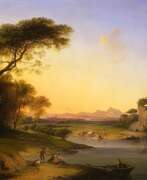

Marco Gozzi was an Italian landscape art painter.
Gozzi worked initially in a broad range of fields including portraiture, religious subjects and decorative frescoes executed in accordance with the Veneto tradition, then still predominant in the region of Bergamo.
While he never held the chair in landscape at the Academy of Brera, he was elected an honorary member in 1829 and qualified as a landscape painter in 1832.




Jan Griffier the Younger was an 18th-century painter active in England.
According to the Netherlands Institute for Art History he was the son of Jan Griffier I and the younger brother of Robert. He lived on Pall Mall and influenced the painter Christian August Lorentzen.


Giacomo Guardi was an Italian painter from Venice. The son of famous veduta painter Francesco Guardi, he continued his father's line of work, though without the same level of renown. The majority of his works are quite small views of only minor artistic interest, more akin to postcards than to his father's grand scenes, but he produced several paintings showcasing a notable level of artistic skill as well. Evaluating his legacy is somewhat complicated due to the frequency with which paintings are misattributed to him.




Jakob Philipp Hackert was a German painter of the second half of the 18th and early 19th centuries. He is known as a landscape painter and printmaker, a representative of neoclassicism and romanticism.
Hackert reached the peak of creative activity in 1770-1780. He was recognized by the European aristocracy, and for a time served as court painter to King Ferdinand IV of Naples, as well as receiving commissions from representatives of the Russian imperial family, such as Empress Catherine II and the heir to the throne, Paul Petrovich. His work, according to critics, was characterized by high craftsmanship and aristocratic elegance.


Johann Gottlob Henschke, a distinguished German landscape artist and copper engraver, was born on September 8, 1771, in Dresden. His life and career were dedicated to creating sepiatinted views of the Dresden and Meissen regions, capturing the essence of German landscapes in his unique style.
Renowned for his precise and evocative landscape drawings and engravings, Henschke's works reflect a deep connection with his homeland's natural beauty. His mastery in depicting landscapes with a keen eye for detail and texture made his work stand out in the artistic community of his time. His contributions were significant in the field of landscape painting in Saxony during the late 18th century.
Henschke's legacy is preserved in various prestigious collections, including the Staatlichen Kunstsammlungen Dresden. His works are a testament to his skill and dedication, capturing the serene beauty of German landscapes that continue to fascinate art collectors, auctioneers, and experts in art and antiques.
For those interested in exploring the tranquil beauty of German landscapes through Henschke's eyes, his works offer a journey back in time, to the picturesque sceneries of 18th-century Dresden. His art not only provides aesthetic pleasure but also serves as a historical document of the landscapes of that era.
To stay updated on new collections, sales, and auction events featuring Johann Gottlob Henschke's works, sign up for our newsletter. This service is exclusively for enthusiasts eager to delve deeper into the world of landscape art and engraving, providing timely updates on opportunities to acquire pieces from Henschke's esteemed collection.


Carl Ernst Christoph Hess, or Carl Ernst Heß was a German copper engraver and painter. He was able to attend the Kunstakademie Düsseldorf where his talents were noticed by its Director, Lambert Krahe. During 1776, he studied engraving in Augsburg and, the following year, worked on the gallery collection that had been initiated by Krahe's son, Peter Joseph Krahe. He became a member of the Academy in 1780, and was promoted to Professor in 1782. That same year, he was appointed as court engraver.




